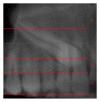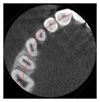Reliability of a novel CBCT-based 3D classification system for maxillary canine impactions in orthodontics: the KPG index
- PMID: 24235889
- PMCID: PMC3817633
- DOI: 10.1155/2013/921234
Reliability of a novel CBCT-based 3D classification system for maxillary canine impactions in orthodontics: the KPG index
Abstract
The aim of this study was to evaluate both intra- and interoperator reliability of a radiological three-dimensional classification system (KPG index) for the assessment of degree of difficulty for orthodontic treatment of maxillary canine impactions. Cone beam computed tomography (CBCT) scans of fifty impacted canines, obtained using three different scanners (NewTom, Kodak, and Planmeca), were classified using the KPG index by three independent orthodontists. Measurements were repeated one month later. Based on these two sessions, several recommendations on KPG Index scoring were elaborated. After a joint calibration session, these recommendations were explained to nine orthodontists and the two measurement sessions were repeated. There was a moderate intrarater agreement in the precalibration measurement sessions. After the calibration session, both intra- and interrater agreement were almost perfect. Indexes assessed with Kodak Dental Imaging 3D module software showed a better reliability in z-axis values, whereas indexes assessed with Planmeca Romexis software showed a better reliability in x- and y-axis values. No differences were found between the CBCT scanners used. Taken together, these findings indicate that the application of the instructions elaborated during this study improved KPG index reliability, which was nevertheless variously influenced by the use of different software for images evaluation.
Figures




References
-
- Cascone P, Schiavoni R, Rizzo G. Impacted teeth: diagnostic and therapeutic problems. Minerva Stomatologica. 1984;33(4):599–608. - PubMed
-
- Pejrone CA. Conservative surgical and othodontic therapy in cases of canine retention. Minerva Stomatologica. 1968;17(10):845–849. - PubMed
-
- Broglia ML, Dana F, Roccia GM. Retention of permanent teeth. Diagnosis and early treatment. Minerva Stomatologica. 1969;18(2):55–78. - PubMed
-
- Marinelli A, Nannelli P. Diagnostic evaluation of abnormally erupted maxillary canines. Minerva Stomatologica. 1999;48(6):265–271. - PubMed
-
- Malagola C, Caligiuri FM, Festa F. Radiographic localization of the impacted cuspid in the upper maxilla. Minerva Stomatologica. 1989;38(8):893–896. - PubMed
MeSH terms
LinkOut - more resources
Full Text Sources
Other Literature Sources
Medical

